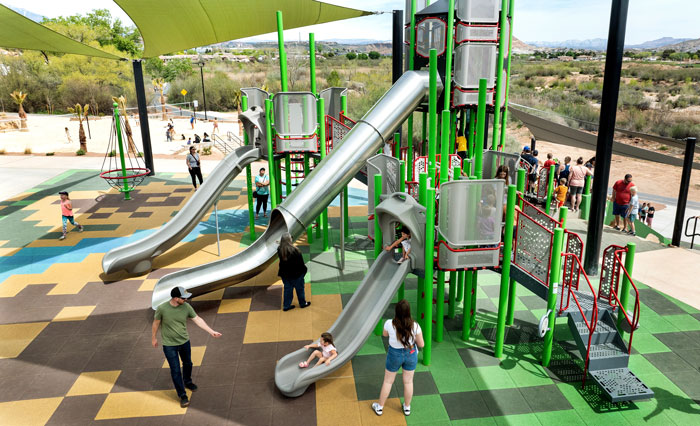For parents and caregivers, it’s a natural sentiment to want to “bubble wrap” the kids before unleashing them on the playground. And in fact, the Consumer Product Safety Commission (CPSC) reports that each year in the U.S., more than 200,000 children go to hospital emergency departments with injuries associated with playground equipment, with nearly 80% of these injuries being caused by falls. But most parents also understand that risk is important for a child’s growth.
“Providing challenging play opportunities is vital for children’s physical development,” said Randy Watermiller, vice president of product development for a Delano, Minn.-based company that designs and manufactures playground spaces and equipment. He explained that ensuring a balanced and safe play environment requires recognizing and eliminating hazards from equipment and surrounding use zones. “This approach allows for both safe play and skill building, enabling children to enjoy fun, engaging play while developing and learning through their experiences.”
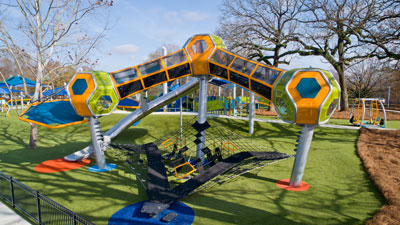
Anne-Marie Spencer, corporate vice president of marketing for a Chattanooga, Tenn.-based company overseeing a diverse range of designers and manufacturers of play and recreation products, said that striking a balance between risk—or perceived risk—and safety is always at the forefront of designers’ minds. “Children need to be able to challenge their abilities in order to develop mentally, physically and socially, but to do so in a way that promotes safety.”
She said the overall height of a play system is one aspect of safety, as it’s “thrilling for kids to climb to a lookout point and see the world around them in a new perspective. The slides that descend from these heights provide a longer ride, and therefore a longer exposure to developing core strength, spatial awareness and confidence.”
To make this safer, designers consider how to fully enclose upper decks and add climbing deterrents on slide exteriors. Spencer also pointed out that building along berms can offer the perception of height, while in actuality the component is never far from the ground.
Larger, taller play structures don’t necessarily translate to riskier play, according to Watermiller. “These designs offer greater challenges that might feel like bigger risks, but in reality children are using the equipment as intended while remaining safe. Conversely, when playgrounds lack sufficient challenge, children may resort to using the equipment in unintended and potentially unsafe ways to seek stimulation.”
He said it’s important for designers to adhere to standards like ASTM (American Society for Testing and Materials) F1487, to identify and mitigate potential hazards effectively. “Additionally, the ASTM F15.29 subcommittee, in collaboration with IPEMA (International Play Equipment Manufacturers Association) members and CPSC staff, is developing requirements to address risks associated with taller structures; standards expected to be integrated into the next revision.”
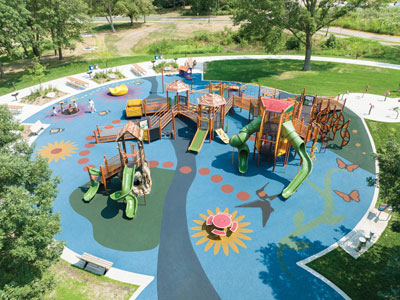
Regular inspections are essential for ensuring that equipment and surfacing meet the manufacturer’s specifications. Watermiller said they provide each play structure with a complimentary maintenance kit, which includes a site-specific binder with maintenance instructions, specialized tools, touch-up paint and guidance to “help owners and operators establish a consistent maintenance program. Beyond regular inspections, periodic audits should be conducted to ensure ongoing compliance with evolving standards.”
He added that there’s also an increasing trend toward the use of third-party inspectors, with “states like California requiring Certified Playground Safety Inspectors (CPSIs) to approve playgrounds before they open to the public.”
Spencer agreed that it’s “absolutely critical” to inspect and maintain playground equipment and surfacing, as with any equipment investment. “I know many parks have CPSIs onsite to inspect tolerances, etc., but there are also employees who perform inspections to regularly ensure things like bolts are tight and in place, vandalism hasn’t occurred and surfacing is maintained.”
The National Recreation and Park Association (NRPA) offers the CPSI certification program, and many state associations also cohost CPSI programs in conjunction with NRPA. In the Madison, Wis., suburb of Sun Prairie, Kristin Grissom, director of Parks, Recreation and Forestry, told us they have one CPSI on staff. “The city pays for the course and provides him with work time for studying and coursework. The course he takes is through NRPA. We do all inspections in-house.”
In Broadview Heights, Ohio, Director of Parks and Recreation Amanda Hutcheson said “We have one CPSI onsite—he’s up for renewal. We pay for it, and he takes it through the Ohio Parks and Recreation Association. He’s a service staff member and makes his rounds weekly to all three playgrounds and reports back to me so I can order and replace any parts that are an issue.”
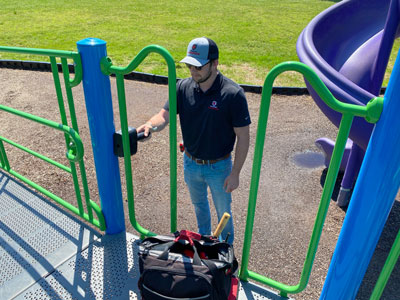
And in the Chicago suburb of St. Charles, Superintendent of Parks and Planning Laura Rudow told us they have five full-time CPSIs on staff, working in their Facilities Department. “They do the low-frequency inspections of all 72 playground structures in our park system as well as co-op playgrounds at the 11 elementary schools.”
Rudow said they have an agreement with the school district to share playground costs at schools, allowing neighborhoods to use the spaces when schools are closed. Parks personnel perform inspections and repairs, and if a significant repair is needed, they bill the school for half the expense. “If it’s a worn bolt or belt swing, we just take care of it.”
Schools, parks and other entities can also hire outside CPSIs to conduct playground inspections. Eddie LaRocque is general manager of a Charlotte, N.C.-based company offering customized, onsite safety inspection services and playground inspection software. And as far as striking that balance between risk and safety considerations, he said it comes down to risk versus hazard. “We’re trying to mitigate risk by removing hazards. Kids need opportunities to take risks safely and negotiate the outcomes, but we’re trying to catch possible hazards so they can be dealt with by the owner/operator before possible injury.”
Regarding the bigger, taller play structures that are becoming more ubiquitous, LaRocque said “there are some great new designs coming out with natural play, towers, etc., that are much more intricate and take quite a bit longer to inspect than traditional play equipment, but it all still needs to comply with CPSC and ASTM for safety.
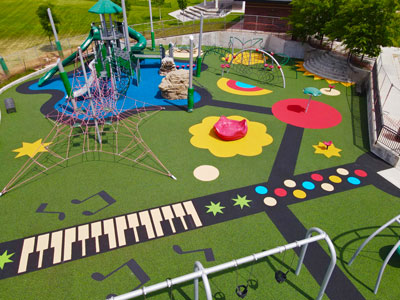
“We use a 31-point CPSI inspection that looks at safety, maintenance and checks for compliance with safety standards and guidelines,” he continued. “The NRPA put out a ‘Dirty Dozen’ checklist that is still useful today, but each manufacturer has an inspection checklist that’s available that should be looked at as well.”
They’ll also look at site characteristics if asked. “We do have customers that bring us in from the beginning to look at layout and design. We also provide ADA assessments (following IPEMA guidelines), fall attenuation testing for safety surfacing, and play area evaluations, which puts a numeric value on each area.”
LaRocque said their inspectors are all CPSIs, and recertify every three years as recommended by NRPA. “We go a step or two further and have additional training from an outside vendor every six months to keep us in the know and see what’s coming and where the industry is headed. We can give some basic training on playground inspections and maintenance programs, but at this time do not offer any type of certification.”
In addition to inspections, LaRocque’s company offers a service that involves cleaning and maintaining equipment and revitalizing play spaces. “We are recoating existing play pieces or amenities onsite. We have two different types of coatings depending on what it is getting applied to. It has been a very successful service that breathes new life back into a worn and weathered playground, giving it a facelift at a fraction of the cost.”
They also offer playground inspection software, which LaRocque said is easy to use for both the inspector and those looking to use the data. “The field inspectors gather data with pictures and text, or voice to text, from inspections that vary from playgrounds to about 50 other types of inspections.” These include skateparks, docks, trails and bleachers. “That data is held in the cloud and can be used in all sorts of reports, work orders for maintenance, and can even be used as an asset management tool to track which type of equipment or pieces of equipment have the most issues.”
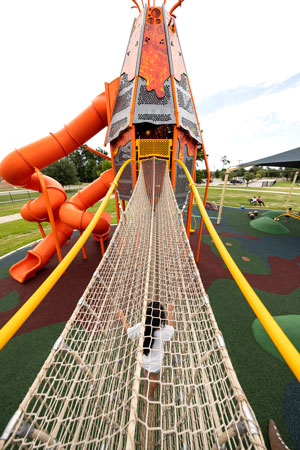
Alan Kavanaugh is director of loss control and risk management for a Prince George, British Columbia-based company offering IT services including park and playground inspection, management and tracking software. He said that using digital checklists is quick and easy, “reducing time and errors while ensuring consistency and compliance.”
The software is fully customizable, “allowing configurations based on location, address, inspection type and specific organizational requirements. Our unique form builder enables the creation of custom inspection forms and reports tailored to the precise needs of any municipality.”
The software has the ability to generate and distribute inspection reports to relevant stakeholders, according to Kavanaugh. “After a facility inspection where issues are found, the report can be sent to all necessary stakeholders, ensuring proper documentation and action on repairs, updates or logistical needs like parts ordering and scheduling for re-inspections.”
Photos can be attached to inspection findings, documenting any issues or general site conditions. “Capturing images for all inspected areas, not just ‘faults,’ is valuable as visual proof of inspection quality… and for liability purposes.”
Kavanaugh said they understand that moving from paper-based to digital processes is a big step, and they offer ongoing support to ease the transition. “We provide complimentary training from day one, covering everything from system setup to advanced features.”
They also offer tailored training on creating and refining inspection checklists, to meet “each organization’s specific needs for planning, compliance and reporting.”
With falls being the primary cause of playground injuries, surfacing is a critical element for safer—and more accessible—play, according to Spencer. Loose-fill surface options include pea gravel and sand, but these have smaller fall height requirements and are not ADA-compliant. There is also rubber mulch, loose fill rubber and engineered wood fiber (EWF), similar to wood chips but designed for playgrounds.
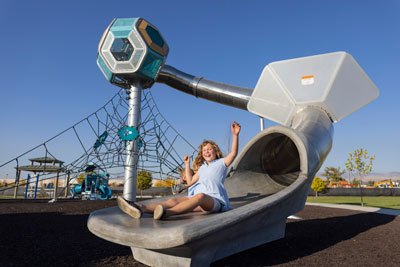
Unitary surfacing options include poured-in-place (PIP) rubber, synthetic tiles and synthetic turf. “Unitary surfacing is highly rated for accessibility and requires less maintenance but can be a greater expense than loose-fill options,” said Spencer. Loose-fill options like EWF, while less expensive, “require ongoing maintenance to remain compliant, including raking to ensure the proper depth is maintained, especially at the base of swings and slides… and must be occasionally topped off.”
Many existing playgrounds still use loose fill surfacing, according to Chris Wolf, general manager for a Corona, Calif.-based manufacturer of playground surfacing. But “owners have tended to shift to unitary surfacing as budgets allow it.” He explained that in the 1980s, early PIP systems were developed for providing ADA pathways, and now, “PIP systems are the most popular type of surfacing in our industry.”
Wolf said they offer several versions of PIP surfacing, with their “standard PIP” being the most popular. There’s also a supreme version which uses smaller granules and special binder. “Other variants include an eco-version, which is high in location-specific tire rubber. All come in a variety of thicknesses to meet the fall height requirements of adjacent playground equipment.”
“Equipment is trending toward larger custom pieces, which leads to higher fall height requirements for playground surfacing,” said AJ Wroblewski, executive vice president of a Williamsville, N.Y.-based manufacturer of recreational and athletic surfacing. He explained that their PIP surface’s thickness can be modified onsite to “meet whatever critical fall height rating is required,” up to 13 feet. And he said their aromatic urethane PIP systems and their aliphatic systems have warranties of seven and 10 years, respectively.
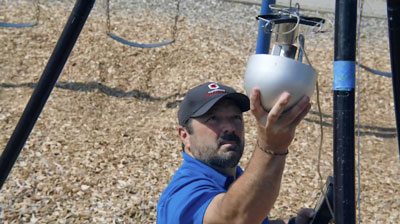
Turf systems are growing in popularity, according to Wolf, including hybrid systems, “which might have a turf area adjoining a PIP system. These make for interesting photo sessions for magazines but aren’t always the best idea due to the undulation junction between system types. It’s really best to go with one system type or the other.” The turf system features a deep pile synthetic turf top layer adhered to a cushion layer, with four- to- 12-foot fall height.
Wroblewski said their rubber tile surfacing is specifically designed to reduce the risk of serious injury associated with falls. He explained that their proprietary manufacturing process—where a top wear layer is bonded to a resilient underlayment—results in an extremely durable surface, and the system can be used indoors or outdoors and is ideal for ground-level playgrounds, rooftop play areas, daycare and afterschool activity areas, plus many other applications.
To help keep costs under control while maintaining aesthetic consistency, Wroblewski’s company also offers a product that is “the top surface layer of the… PIP system. It also consists of EPDM and polyurethane. (It’s) commonly used in play areas without equipment and in portions of playgrounds outside the equipment’s use zone.”
He also pointed out that their PIP system “provides the capability of incorporating custom colors, logos, games and/or geometric shapes into any playground surface.”
Wolf said they currently have a palette of 24 colors for top layers. “Simple color swaths are often employed to define either 2-to-5 or 5-to-12 age group areas,” and are used frequently when surfacing large areas. As far as custom designs and graphics, “my general feeling is that for most municipal parks, designers would do better to simplify or remove graphics. They look interesting at first, but can come back as problem areas later in the service life of the pads.”
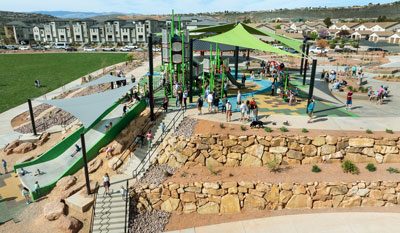
Wolf pointed out that the PIP systems require no daily maintenance, unlike loose fill surfaces, which require “raking or filling of wallowed-out areas. PIP stays put and only requires a monthly visual check in most cases. Repairs are easily done on PIP systems when necessary.”
He explained that some older systems can benefit from a recoating using special poly resin, “which serves as a re-saturant that locks in loose granules and freshens up the appearance.” Typically playgrounds are first pressure washed, allowed a day to dry and then resin is applied. “This can be done a couple times in the service life of the pad.”
But Wolf cautioned that some companies tie their warranty requirements to “an excessive recoating schedule”—every couple of years. He advises avoiding this due to cost, as well as because “excessive recoating can reduce the porosity of the pad and in some cases can cause ponding. You want a pad that flows rainwater. In most cases an annual review of the owner’s playground pads will show which pads would benefit from recoating.”
“Effective playground planning starts with strong collaboration between the manufacturer, designer and owner/operator of the playground,” said Watermiller. He said this approach helps address critical considerations such as environmental factors, anticipated usage and accessibility needs.
“Additionally, always opt for qualified, factory-certified installers to manage the installation of equipment and surfacing to ensure both safety and quality. Finally, developing a comprehensive plan that includes a budget for ongoing maintenance is essential to keep the playground in top condition for years to come.”
“We provide education through a playground safety and maintenance guide, as well as a supervision guide, which are both great foundations to build upon,” said Spencer.
They also offer webinars on the topic through their free CEU platform. “Playground safety is everyone’s business, from the designers and manufacturers who make the equipment to the installers who ensure it’s built to standards, to the owner/operators who maintain and supervise the site, to parents at the park who ensure their children are using the space in the way it was intended.” RM



